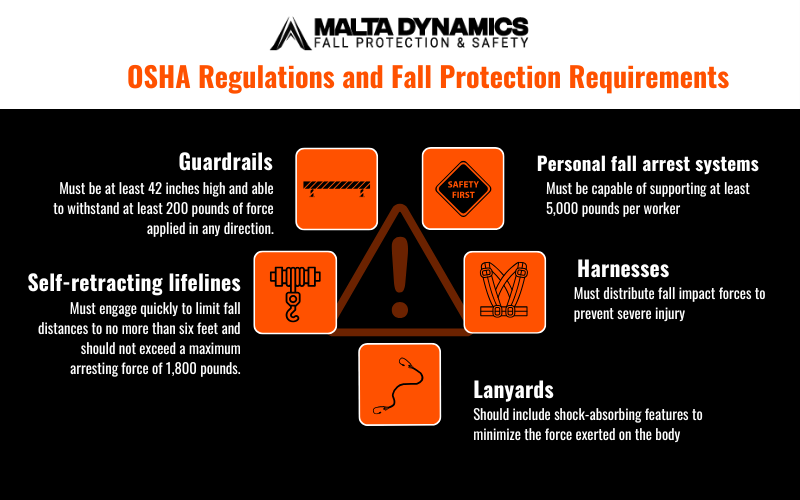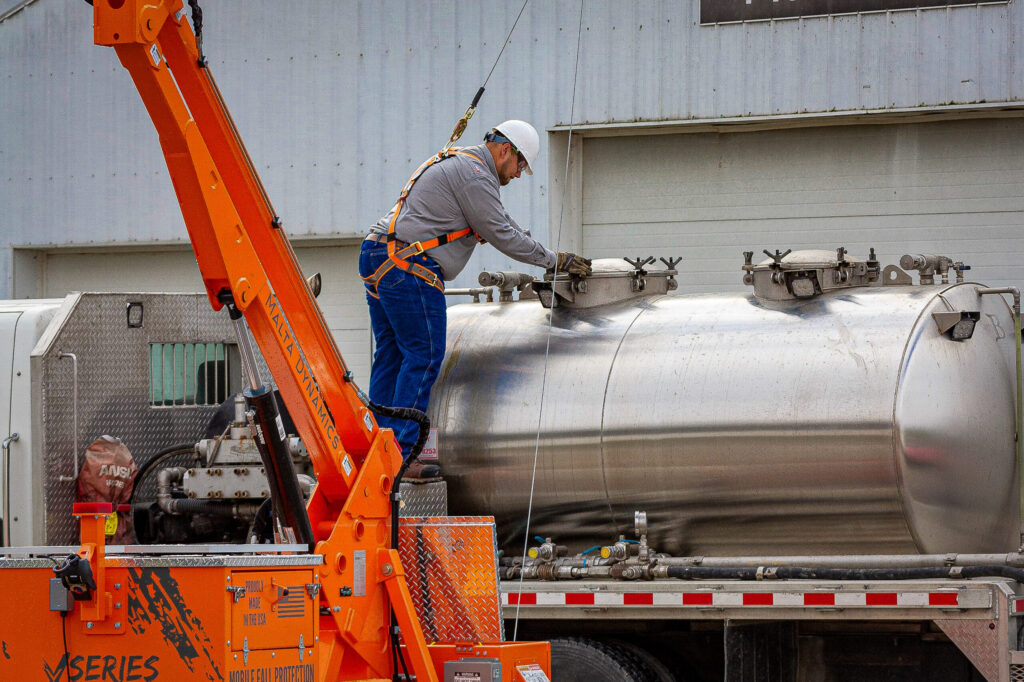Working in oil fields is one of the most dangerous jobs in the United States. The combination of extreme conditions, heavy equipment, and elevated workspaces makes falls a leading cause of injuries and fatalities. The oil and gas extraction industry has one of the highest fatality rates, with falls contributing to a significant number of workplace incidents each year.
For oilfield workers, understanding fall risks and how to mitigate them is critical. Employers and contractors must prioritize worker safety by adhering to OSHA regulations, implementing proper training programs, and ensuring access to reliable personal protective equipment (PPE). Let’s explore the biggest fall hazards on oil fields, OSHA’s safety requirements, and how to keep your crew protected.
Oilfield locations present many hazards that are unique to this industry. Sites are often on newly constructed gravel and dirt roads that won’t appear in navigation apps or online maps, there are elaborate and prolonged traffic patterns. Sites are also often far from emergency services, and in cellular dead zones. Some areas present hazards similar to a commercial construction site with dynamic changes to loading/unloading areas, and all locations for all operations are temporary, as production sites are expected to be returned to something near their previous state after drilling and completion work. Sometimes all that’s left is an access road and a wellhead.
Some phases of oil and gas production present hazards more familiar to a chemical production facility, with pipe racks, high pressure lines, explosion hazards, and combustible materials.
Some phases are more similar to Forestry and Logging. The frequency of change in safety hazards is very unique to the Oil and Gas industry, it takes a team of safety professionals with specialty in multiple industries.
Add into that the vast number of operating companies, service companies, and single service companies on every site, making up no less than 10-15 employers for the 30-100 workers on site at a time. A multi-lateral well in the hydraulic fracture phase may have over 20 pumper trucks, blender trucks, data vans, dozens of water storage tanks, 20-30 pickup trucks, living quarters for key personnel, and a steady flow of semi trucks bringing in water and sand for the operation, all on a 3-5 acre site. It’s not a wonder that fatalities in oil and gas are higher than other industries simply due to the width and depth of hazards this industry faces.
Common Fall Hazards in Oil Field Jobs
Oil field operations take place in unpredictable environments with constantly evolving hazards that put workers at risk. Some of the most common causes of falls include:
1. Unstable Walking Surfaces
Oil rigs, drilling platforms, and scaffolding create dangerous working conditions, especially when surfaces become slick with oil, mud, or ice. Extreme cold temperatures can also lead to icy conditions, increasing slip-and-fall risks. Without proper fall protection measures, workers face serious safety risks.
2. Improper Use of Ladders and Scaffolding
Oil field workers frequently use temporary work platforms that may not be properly secured. Climbing onto machinery, storage tanks, or high structures without proper guardrails or secured ladders increases the likelihood of falls and severe injuries.
3. Lack of Fall Protection Equipment
Many fall-related injuries occur due to missing or inadequate personal protective equipment. Harnesses, self-retracting lifelines (SRLs), and anchorage points are essential for worker safety, yet they are often neglected or used improperly.
4. Harsh Weather Conditions
Oil fields are exposed to extreme weather conditions, from high winds to heavy rain and snow. Working at elevated heights in these conditions significantly increases fall risks, requiring additional safety measures.
5. Emergency Situations & Explosions
Fires, structural collapses, and explosions caused by the improper handling of hazardous materials can lead to unexpected falls. Gas companies and contractors must have emergency protocols in place to protect workers from secondary injuries caused by such incidents.
OSHA Regulations and Fall Protection Requirements
The Occupational Safety and Health Administration (OSHA) enforces strict safety standards for the oil and gas industry. These regulations are designed to minimize worker injuries and fatalities due to falls.
Key OSHA Fall Protection Standards:
Employers must provide fall protection for work performed at heights of six feet or more.
Guardrails, safety nets, and fall arrest systems are required where fall hazards exist.
Workers must undergo fall prevention training to recognize hazards and properly use PPE.
Oil field contractors must conduct regular safety inspections to ensure compliance with OSHA regulations.
By enforcing these standards, OSHA aims to reduce the high injury and fatality rates associated with falls in the gas extraction industry. Compliance with these regulations not only protects workers but also helps employers avoid costly fines and liabilities.
Essential Fall Protection Equipment and Training
Investing in the right safety equipment and training programs can drastically reduce fall-related injuries.
OSHA regulations mandate that all personal fall arrest systems must be capable of supporting at least 5,000 pounds per worker. Harnesses must distribute fall impact forces to prevent severe injury, and lanyards should include shock-absorbing features to minimize the force exerted on the body. Self-retracting lifelines (SRLs) must engage quickly to limit fall distances to no more than six feet and should not exceed a maximum arresting force of 1,800 pounds. Additionally, guardrails must be at least 42 inches high and able to withstand at least 200 pounds of force applied in any direction. Helmets, gloves, and protective gear are required for additional safety measures in high-risk environments.
For full OSHA fall protection standards, visit OSHA Fall Protection Regulations.
Why Training Programs Matter
Training programs teach workers how to identify fall hazards, properly use PPE, and respond to emergencies. Safety management experts recommend routine fall protection training to ensure compliance and enhance personal safety.
A unique program tailored to the oil and gas industry helps workers stay up to date on OSHA requirements and best practices. Employers should implement comprehensive programs that align with OSHA data on workplace safety and injury prevention.
How Malta Dynamics Supports Fall Protection in the Oil Field Industry
Malta Dynamics is a leading provider of fall protection solutions designed to keep oil field workers safe. Our OSHA-compliant PPE, safety training programs, and industry expertise make us the trusted choice for employers and contractors in the gas extraction industry. Employers trust us because we help oil field employers comply with OSHA regulations, our equipment reduces the risk of workplace injuries and fatalities, and we provide ongoing support services to ensure safety compliance across operations.
A dynamic environment deserves dynamic protection. Our XSERIES line of mobile fall protection products has been a favored safety choice for many oilfield operations and can often be found solving complex height safety issues on sites all over the country.
Industry-Leading Fall Protection Equipment
We offer a full range of high-quality fall protection gear, including:
- ANSI and OSHA-certified harnesses
- Self-retracting lifelines (SRLs) for oil rig safety
- Guardrail systems for elevated workspaces
- Anchor points and tie-off solutions for secure work positioning
Comprehensive Fall Safety Training
We provide specialized training programs tailored for oil field workers, ensuring they understand fall hazards and how to prevent them. Our courses cover OSHA fall protection regulations, best practices for working at heights, and emergency response procedures. Workers learn how to properly use personal protective equipment and navigate high-risk environments with confidence. Regular training updates keep oil field personnel informed about evolving safety standards and industry requirements, reducing the risk of injuries and fatalities on the job. We provide specialized training programs tailored for oil field workers, making sure they understand fall hazards, how to prevent them, and emergency response procedures.
Take Action: Protect Your Workers Today
Falls are preventable with the right equipment, training, and commitment to safety. Whether you’re an employer, contractor, or safety expert, investing in fall protection is essential for reducing injuries and fatalities in the oil field industry.
Explore Malta Dynamics’ comprehensive safety solutions today and guarantee protection for your team.
